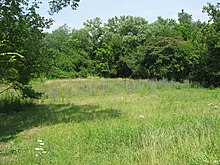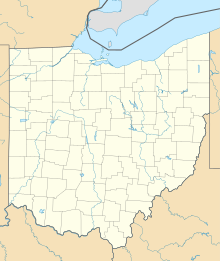Clough Creek and Sand Ridge Archeological District
Coordinates: 39 ° 6 '46 " N , 84 ° 23' 48" W.
The Clough Creek and Sand Ridge Archeological District is a listed ensemble of two archaeological sites in Hamilton County in southwest Ohio in the United States . Its name is determined by the two sites: one is on Clough Creek , a tributary of the Little Miami River , and the other forms part of the sand dune near the creek.
Clough Creek
The Clough Creek Site occupies an area of approximately 8,000 square feet; although no excavations have taken place at this point , it is believed that an extensive prehistoric village was located here.
Sand ridge
The Sand Ridge Site is approximately 500 meters from the Clough Creek Site. Located on a clearly recognizable ridge line west of the old Union Bridge along the road from Cincinnati to Batavia , this site has long been a significant excavation site. As early as the 1880s, the site was visited by people collecting artifacts from the surface, such as bones, shards and pieces of flint . The previous residents did not live in the area year-round, most likely only in autumn and winter. It appears that a large part of their diet consisted of caught fish, as many bones were found in the Sand Ridge; among the most common fish species were moxostoma , ictalurus punctatus, and freshwater drummers .
Excavations and conclusions
On behalf of the Peabody Museum of Archeology and Ethnology , archaeologists examined Shell middens on the Sand Ridge in 1884 . They were able to add a variety of other artifacts to the museum's collections, including stone tools , poultry and game bones, and projectile points . In recent years, the Clough Creek site has attracted attention for surface artifacts. According to archaeologists, artifacts are buried up to 1.5 m deep in the ground at this point.
Despite the short distance between the two sites, it is assumed that they are closely related to each other. Artifacts found at the Sand Ridge Site suggest they belong to the Madisonville Focus of the Fort Ancient culture . This mapping is primarily based on the discovered dishwashers, which are similar to those of the Madisonville and State Line sites. One of the distinguishing features of the Sand Ridge Site is the presence of artifacts from two chronologically different cultures: the Fort Ancient village was apparently built on the site of an earlier village from the late Woodland period .
Ground monument
In 1974 the Clough Creek and Sand Ridge Archeological District was added to the National Register of Historic Places because it is a potential source of information. In Newtown further east there are several settlement sites that have been given comparable status: the Perin , Turpin, and Hahn Field Sites. Like Clough Creek and Sand Ridge, Turpin and Hahn Field were once Fort Ancient villages founded on settlements from the earlier Woodland Period, while Perin Village and the related Odd Fellows' Cemetery Mound were entirely from the Woodland Period.
supporting documents
- ^ Ohio Atlas & Gazetteer , 7th Edition, DeLorme, Yarmouth , Maine 2004, ISBN 0-89933-281-1 , p. 75.
- ↑ a b c d e f g Lorrie K. Owen (Ed.): Dictionary of Ohio Historic Places , Volume 1. Somerset, St. Clair Shores , Michigan 1999.
- ^ A b Annual Report of the Trustees of the Peabody Museum of American Archeology and Ethnology , Volume Vol. 3. Wilson and Son, Cambridge 1887.
- ↑ Thomas E., et al. Emerson: Late Woodland Societies: Tradition and Transformation across the Midcontinent . U of Nebraska P , Lincoln , Nebraska 2000, p. 84.
- ↑ a b c Kathleen Brady Rawlins: The OC Voss Site: Reassessing What We Know about the Fort Ancient Occupation of the Central Scioto drainage and Its Tributaries ( English , PDF): Diss. . Ohio State University . 2007. Retrieved June 17, 2010.
- ^ Entry in the database of the National Register of Historic Places

